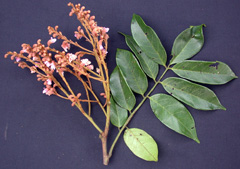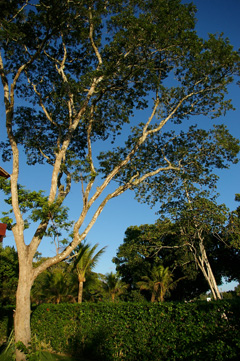 |
|
https://edibleplants.org/ |
 |
| https://edibleplants.org/ |
Translate this page:
Summary
Tatabu or Diplotropis purpurea is an evergreen tree found in South America specifically in northern Brazil, with a round, sparse crown and not buttressed cylindrical bole of up to 60 cm in diameter. It can grow up to 30 m in height. It is harvested from the wild for local use and export for its timber. It is one of the strongest and most beautiful woods. The wood is very hard, heavy, strong and moderately resistant to decay but is difficult to work.
Physical Characteristics

 Diplotropis purpurea is an evergreen Tree growing to 25 m (82ft) by 20 m (65ft) at a medium rate.
Diplotropis purpurea is an evergreen Tree growing to 25 m (82ft) by 20 m (65ft) at a medium rate.
See above for USDA hardiness. It is hardy to UK zone 10.
It can fix Nitrogen.
Suitable for: light (sandy), medium (loamy) and heavy (clay) soils and prefers well-drained soil. Suitable pH: mildly acid, neutral and basic (mildly alkaline) soils. It can grow in semi-shade (light woodland) or no shade. It prefers dry or moist soil and can tolerate drought.
UK Hardiness Map
US Hardiness Map
Synonyms
Bowdichia brasiliensis (Tul.) Ducke Bowdichia guianensis (Tul.) Ducke Dibrachion guianense Tul. Dipl
Plant Habitats
Edible Uses
References More on Edible Uses
Medicinal Uses
Plants For A Future can not take any responsibility for any adverse effects from the use of plants. Always seek advice from a professional before using a plant medicinally.
None known
References More on Medicinal Uses
The Bookshop: Edible Plant Books
Our Latest books on Perennial Plants For Food Forests and Permaculture Gardens in paperback or digital formats.

Edible Tropical Plants
Food Forest Plants for Hotter Conditions: 250+ Plants For Tropical Food Forests & Permaculture Gardens.
More

Edible Temperate Plants
Plants for Your Food Forest: 500 Plants for Temperate Food Forests & Permaculture Gardens.
More

More Books
PFAF have eight books available in paperback and digital formats. Browse the shop for more information.
Shop Now
Other Uses
Furniture Wood
Other Uses: Freshly cut heartwood is generally chocolate brown, turning to a lighter brown when dry, and may occasionally be greyish brown or brown, often with dark gold-coloured stripes or narrow stripes of a lighter brown; it is clearly demarcated from the narrow band of greyish or pinkish gray sapwood[ 378 ]. The grain is straight to slightly interlocked or sometimes slightly wavy; the texture is coarse to very coarse; the lustre is high and golden in the proper light, often with a waxy appearance; no distinctive odour or taste is present[ 378 ]. The wood is very hard, heavy, tough, strong and generally considered to be moderately resistant to decay, although tests at Yale University indicate the wood is very durable in resistance to both white-rot and brown-rot fungus[ 378 ]. The wood is moderately difficult to work; it saws rather easily, but is somewhat difficult to plane because of its frequently roey grain, which when present requires considerable sanding; it turns well; has high screw-holding power; and takes wax or polish satisfactorily if a filler is first applied[ 378 ]. It is used for heavy construction, boatbuilding, house framing, flooring, furniture, and turnery. The timber's recognized beauty should promote its extensive use for furniture, cabinetwork, marine construction in non-teredo waters, and other similar uses in the countries of origin and on the export market. Its very good strength properties also suggest its use for tool handles and agricultural tools and vehicles[ 378 ].
Special Uses
Nitrogen Fixer
References More on Other Uses
Cultivation details
Succeeds in full sun to dappled shade[ 420 ]. Prefers a well-drained soil[ 420 ]. Established plants are drought tolerant[ 420 ]. Newly planted young trees usually grow away moderately quickly[ 420 ]. This species has a symbiotic relationship with certain soil bacteria; these bacteria form nodules on the roots and fix atmospheric nitrogen. Some of this nitrogen is utilized by the growing plant but some can also be used by other plants growing nearby[ 755 ].
References Carbon Farming Information and Carbon Sequestration Information
Temperature Converter
Type a value in the Celsius field to convert the value to Fahrenheit:
Fahrenheit:
The PFAF Bookshop
Plants For A Future have a number of books available in paperback and digital form. Book titles include Edible Plants, Edible Perennials, Edible Trees,Edible Shrubs, Woodland Gardening, and Temperate Food Forest Plants. Our new book is Food Forest Plants For Hotter Conditions (Tropical and Sub-Tropical).
Shop Now
Plant Propagation
Seed - best sown as soon as it is ripe in a lightly shaded position in a nursery seedbed[ 420 ]. Germination rates are usually high, with the seed sprouting within 14 - 21 days[ 420 ]. Prick out the seedlings into individual containers when they are 4 - 5cm tall and they should be ready to plant out 5 - 6 months later[ 420 ].
Other Names
If available other names are mentioned here
Native Plant Search
Search over 900 plants ideal for food forests and permaculture gardens. Filter to search native plants to your area. The plants selected are the plants in our book 'Plants For Your Food Forest: 500 Plants for Temperate Food Forests and Permaculture Gardens, as well as plants chosen for our forthcoming related books for Tropical/Hot Wet Climates and Mediterranean/Hot Dry Climates. Native Plant Search
Found In
Countries where the plant has been found are listed here if the information is available
Colombia; Ecuador; French Guiana; Guyana; Peru; Suriname; Venezuela, Bolivarian Republic of; Bolivia, Plurinational State of; Brazil
Weed Potential
Right plant wrong place. We are currently updating this section.
Please note that a plant may be invasive in one area but may not in your area so it’s worth checking.
Conservation Status
IUCN Red List of Threatened Plants Status : Status: Least Concern

Growth: S = slow M = medium F = fast. Soil: L = light (sandy) M = medium H = heavy (clay). pH: A = acid N = neutral B = basic (alkaline). Shade: F = full shade S = semi-shade N = no shade. Moisture: D = dry M = Moist We = wet Wa = water.

Expert comment
Author
(Rich.) Amshoff
Botanical References
Links / References
For a list of references used on this page please go here
A special thanks to Ken Fern for some of the information used on this page.
Readers comment
| Add a comment |
|
If you have important information about this plant that may help other users please add a comment or link below. Only comments or links that are felt to be directly relevant to a plant will be included. If you think a comment/link or information contained on this page is inaccurate or misleading we would welcome your feedback at [email protected]. If you have questions about a plant please use the Forum on this website as we do not have the resources to answer questions ourselves.
* Please note: the comments by website users are not necessarily those held by PFAF and may give misleading or inaccurate information.
To leave a comment please Register or login here All comments need to be approved so will not appear immediately.
|
Subject : Diplotropis purpurea
|
|
|
|